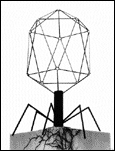Letter to the Editor: The Late, Great Phage Was Many Things to Many People
Posted February 17, 1999
 |
I saw your nifty article on phageT4 in the Berkeleyan [Feb. 3, 1999] and thought I would write to tell you what I know about the sculpture.
I'm a graduate student who works in Barker Hall. I used to walk by the bacteriophage every day. It first appeared on the pedestal on June 25, 1996. Often one could find birds sitting on the wooden crossmembers, as if the capsid (the spherical head part) was acting as a set of tree branches or a giant bird cage.
In February 1997, a severe windstorm proved to be too much, and the wooden head structure snapped off the base. The decapitated phage disappeared by the next day.
Then on Aug. 3, 1998 the sculpture reappeared on the pedestal, looking almost exactly as it had before, except this time the capsid was constructed out of shiny copper pipe.
The exact origin of the phage sculpture appears to be unknown. In the spring of 1996, a white papier-mích» gargoyle appeared on the pedestal overlooking Oxford Street. A small piece of paper on the steps next to the pedestal had a drawing of the pedestal with a phage particle on it and people on the steps bowing in prayer to the phage. The words, "Next week: PhageT4 God," were written on the paper.
We (myself and some other graduate students) thought there was some art class project to produce a sculpture a week, or that some guerrilla artist had found a lonely pedestal to decorate. The gargoyle eventually dissolved and keeled over. Weeks and months passed but the phage did not appear. Not until June.
I don't know who destroyed the phage, or why. Most people who worked in Barker or Koshland found it an easily recognizable biological structure. We all miss it.
Chris Seidel
Department of Molecular and Cell Biology
Kane Lab, 614 Barker Hall
![]()
![]()
February 17 - 23, 1999 (Volume 27, Number 23)
Copyright 1999, The Regents of the University of California.
Produced and maintained by the Office of Public Affairs at UC Berkeley.
Comments? E-mail berkeleyan@pa.urel.berkeley.edu.